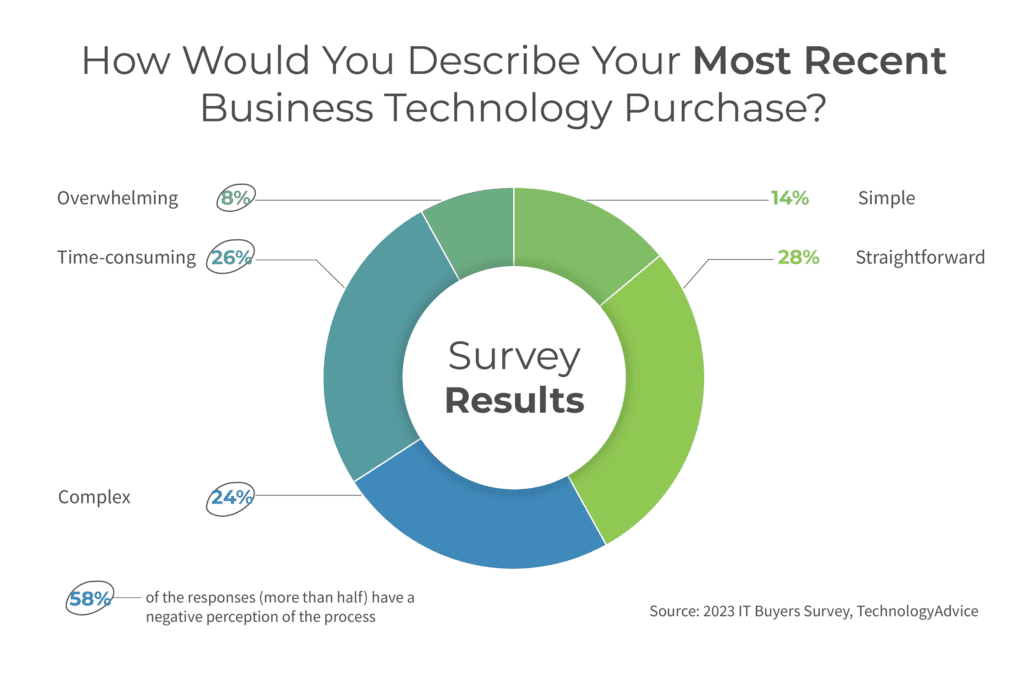The B2B technology buying process is full of complexity and risk for B2B buyers. There are often dozens of software applications and technology tools available to meet the business needs of buyers.
For B2B marketers, for example, there are more than 11,000 martech applications available on the market, offering everything from data enrichment to marketing automation and analytics.
Deciding which product to buy can be a time-consuming decision for anyone. In the B2C world, a purchase worth more than a couple hundred dollars might require some product research and maybe a conversation with a spouse, partner, or family.
In B2B, however, purchase decisions are made by committees consisting of as many as four, eight, or even 12 people. Members of the committee often have different roles in the organization, different responsibilities, and different goals and business objectives they need to achieve.
There’s another group of people involved in B2B tech purchases as well. They are the purchase influencers. They don’t necessarily do the research or come to a conclusion. Instead, they lurk around the edges of the committee. You see them in the breakroom after the committee has a meeting or they’re on your next video call. They like to recommend tools or features they think deserve consideration, or they have a former colleague who worked with one of the vendors under consideration. They play an informal role in the process.
RELATED PODCAST: How Business Users Change the Game of B2B Marketing
It wasn’t always this complicated. Twenty-five years ago, most business software and technology purchase decisions were made by IT professionals. They decided which tools would be purchased and deployed to users. It wasn’t uncommon for the tech team themselves to be the sole users of many of the products.
Today, software is ingrained in every business process. Business users, who may not be as familiar with buying business tech, are now heavily involved in the buying process, along with IT, legal, finance, and procurement, to name a few.
You can see why this gets really complicated really quickly. Business users will be most interested in features and the time savings from adopting a fancy new tool. IT will be concerned with integration and security. Finance will be interested in the cost of the license. Legal will take a close look at the terms of the contract.
Get a “No” from any of these roles on anything they’re focused on, and your deal is sunk.
RELATED ARTICLE: Understanding Differences in B2B Buying Groups
Trying to come to a decision – any decision – when so many people and so many products are in play amplifies the complexity of the B2B buying process. When things are complex, most people seek to simplify them. And in B2B buying, two possible outcomes of the buying process are designed to do just that.
How Buyers Try to Reduce Complexity
One outcome that appeals to people trying to reduce complexity is to simply do nothing at all. In a complex and overwhelming buying process, where so many voices are involved, some B2B buying committees will throw up their hands and decide, “What we have now isn’t all that bad after all.”
For this reason, many B2B tech vendors often find themselves competing against the status quo instead of other vendors. Buying committee members are trying to assess the risk and reward of investing in a new tech tool or platform. And while the status quo may not always be a wise business decision in terms of transforming the organization and beating the competition, it might be the decision that best allows everyone to get a good night’s sleep.
That leaves buying committees often asking themselves this question: What carries more risk, making a decision to maintain the status quo, or making the wrong decision on a new investment?
Risk is inherent in the B2B tech buying process. Teams bring new tools into the organization, but that’s just the beginning. They need to:
- Effectively deploy the tools
- Convince their users to use the tools
- Integrate the new tools with existing tools and systems
- See a return on their investment in the tools.
And perhaps most risky of all: They’re doing all of this with other people’s money.
That’s part of the temptation of the status quo. When buyers decide against making a change, the other people’s money stays in the bank.
Beyond maintaining the status quo, there’s another outcome that appeals to buyers looking for simplicity: Go with what’s familiar. After all, there’s a reason that generations of tech buyers have quoted the famous cliché, “No one ever got fired for buying IBM.”
Like most clichés, this one has an element of truth. IBM is a big brand with a long track record in the technology industry. Every B2B tech buyer instantly recognizes the IBM logo. But like every brand, IBM’s brand is more than a logo. Strong brands are built on trust.
When buyers are interested in making a change from the status quo and they’re seeking to reduce complexity and risk, they will often gravitate toward brands they know and trust.
Do B2B Brands Have a Trust Problem with Buyers?
Trust is one of our most powerful emotions. It feels good to know you’re trusted and that you can trust people. Trust means safety and honesty. People we trust are low risk. They will listen to us, advise us well, and take care of us.
And that’s why trust struggles to translate well in business relationships. Like the B2B buying process, most things that happen in a business relationship involve more than one person.
RELATED ARTICLE: Is Your Marketing Content Self-Centered?
You may trust your favorite restaurant to serve you a good meal at a fair price with good service. But then one day you encounter a server having a bad day. That experience wasn’t the best. But did it affect how much you trust that business?

More than half (58 percent) of the respondents to the 2023 IT Buyers Survey from TechnologyAdvice said they found their most recent business technology purchase to be overwhelming, complex, or time consuming.
It’s difficult to build trust with buyers seeking to reduce complexity and risk if they see the purchase process itself as difficult. That’s only the first phase of the relationship. If things are complex before the purchase, buyers will immediately wonder what the customer service experience will have in store for them after the deal is closed.
A familiar brand often means a company is established, trusted by others, and has a track record of success. With thousands of tech tools and applications on the market, a strong brand helps narrow down the list of products and vendors.
When TechnologyAdvice asked respondents to the 2023 IT Buyers Survey to rank the factors that influenced their most recent purchase decision on a scale of one (least influential) to five (most influential), brand familiarity carried the most influence.
Also telling is what respondents to the survey said carried the least influence on their purchase.
Social media, an area where trust has long been an issue, and professional networks, where the people might be strangers or casual acquaintances at best, were cited as the least influential factor by 16 percent of respondents.
But the single least influential factor for B2B tech buyers (cited as least influential by more than 20 percent of respondents) was vendor-created content and sales interactions.
Ouch. That hurts.

How to Build Brand Trust with B2B Buyers
IBM was founded in 1911. None of us were around at the time. But we can safely assume it did not have instant brand recognition and the trust of its market by, let’s say, 1912.
Brand familiarity can be achieved with an innovative product, a well-designed marketing strategy, and a lot of luck. Some companies, for example, land that big customer who tells the world all about them. Some vendors fall into a feature story in a major news publication. Others ride the coattails of a charismatic founder.
RELATED ARTICLE: What Is Brand to Demand? And Why Does it Matter?
A number of factors can quickly propel a brand from unknown to instant recognition. (And it’s worth noting, not all of them are positive; like a data breach, for example.)
Brand trust, which is what B2B buyers need to start and complete the buying process, takes much longer. Building brand trust requires top-notch execution across the organization in addition to a solidly designed marketing strategy and a must-have product.
Does that mean vendors with little brand recognition will lose out on a lot of business while they build their brand? Of course not. Not every vendor catches brand lightning in a bottle. Instead, they build familiarity and trust with B2B buyers the old fashioned way: they earn it.
These vendors need to ensure their unique value proposition is communicated clearly in their marketing and sales efforts. They need to identify and target their ideal customer profile (ICP), as well as the other members of the committee who make purchase decisions for their products. Their demand generation strategy should include a focus on educating their market and helping buyers reduce risk and complexity, instead of pushing the hard sell.
But those demand generation efforts will work more effectively if they’re working in conjunction with brand marketing tactics. B2B tech buyers are more likely to respond to offers, download assets, and engage with content from brands they know.
So how do you start building the foundation for a trusted brand?
RELATED PODCAST: Why B2B Brands Need to Embrace Emotion and Education
Six Ways to Start Building Trust in Your B2B Brand
Here are six tactics B2B tech vendors of any size can use to start building trust with their prospects and customers.
Provide educational content
Educational content helps B2B tech buyers better understand the technology and its potential impact on their organization. It can even help them understand the business problem they’re facing or help them anticipate business problems they might face in the future. Various content marketing assets, like articles, whitepapers, and case studies, can deliver valuable insights to B2B buyers by providing more value than a sales pitch.
Free trials or demos
Earlier in this piece we discussed how buying committees represent a significant difference between B2C and B2B buying journeys. To use another B2C example, you’re unlikely to buy a car without a test drive. Giving your buyers the opportunity to try out a product or service before committing to a purchase will build trust and confidence in your brand. They will be more comfortable with the product and its capabilities after they try it out.
Personalize their buying experience
B2B marketers have a wealth of data and analytics tools that will help personalize the buying experience for individual customers available to them. This can extend from carefully targeted marketing messages to offering customized pricing and personalized support and customer service.
Establish thought leadership
A lot of B2B tech vendors create thought leadership content. But too often thought leadership turns into a sales pitch. Effective thought leadership content sets up your employees and executives as experts in your industry. In doing so, it builds trust and credibility with the audiences. Whether the content is distributed as speaking engagements, blog posts, social media content, or other formats, thought leadership tells your buyers that you understand the world where they operate.
Communicate clearly and consistently
Clear and consistent communication, from that initial outreach to post-sale messages, builds trust with B2B buyers. Early on, it might take the form of transparent pricing information, then progress to accurate timelines and regular updates from the customer success team.
Focus on customer success
Vendors that focus on the sale at the expense of what comes next are ignoring the customer lifecycle. B2B marketers can work with customer success to focus on helping their customers achieve their goals and succeed in their business. This means providing ongoing support, training, and resources to ensure that customers are getting the most value from the solution they purchased.
Balance Your Brand and Demand Marketing Effort
The combination of performance marketing tactics and martech applications promised B2B executives they could more accurately measure the return on their marketing investments down to the dollar. But the complexity of the buying process – in particular the many members and influencers – led many marketing organizations to get caught up in attribution instead of the true goal: revenue.
Marketing organizations that focus on both brand and demand are better aligned with their buyers’ journey. B2B tech buyers encounter both brand building and performance marketing tactics as they do research and consider vendors. The two tactics support each other.
But building a brand that buyers recognize and trust isn’t a job for the marketing team alone. It requires a company-wide strategy that touches every department, from the executives and sales team to customer success and support.





